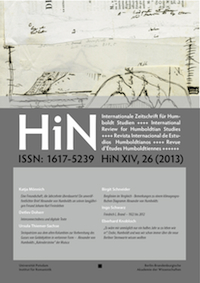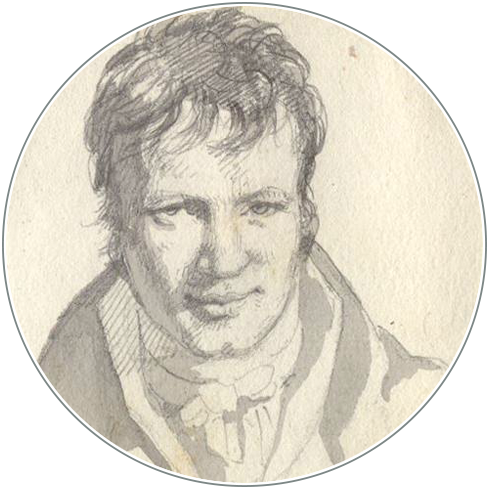Interconnectedness und digitale Texte
DOI:
https://doi.org/10.18443/174Schlagworte:
Digital Humanities, Digitalisierung, Humboldt Digital LibraryAbstract
Zusammenfassung
Die multimedialen Informationsdienste im Internet werden immer umfangreicher und umfassender, wobei auch die nur in gedruckter Form vorliegenden Dokumente von den Bibliotheken digitalisiert und ins Netz gestellt werden. Über Online-Dokumentenverwaltungen oder Suchmaschinen können diese Dokumente gefunden und dann in gängigen Formaten wie z.B. PDF bereitgestellt werden.
Dieser Artikel beleuchtet die Funktionsweise der Humboldt Digital Library, die seit mehr als zehn Jahren Dokumente von Alexander von Humboldt in englischer Übersetzung im Web als HDL (Humboldt Digital Library) kostenfrei zur Verfügung stellt. Anders als eine digitale Bibliothek werden dabei allerdings nicht nur digitalisierte Dokumente als Scan oder PDF bereitgestellt, sondern der Text als solcher und in vernetzter Form verfügbar gemacht. Das System gleicht damit eher einem Informationssystem als einer digitalen Bibliothek, was sich auch in den verfügbaren Funktionen zur Auffindung von Texten in unterschiedlichen Versionen und Übersetzungen, Vergleichen von Absätzen verschiedener Dokumente oder der Darstellung von Bilden in ihrem Kontext widerspiegelt.
Die Entwicklung von dynamischen Hyperlinks auf der Basis der einzelnen Textabsätze der Humboldt‘schen Werke in Form von Media Assets ermöglicht eine Nutzung der Programmierschnittstelle von Google Maps zur geographischen wie auch textinhaltlichen Navigation.
Über den Service einer digitalen Bibliothek hinausgehend, bietet die HDL den Prototypen eines mehrdimensionalen Informationssystems, das mit dynamischen Strukturen arbeitet und umfangreiche thematische Auswertungen und Vergleiche ermöglicht.
Summary
The multimedia information services on Internet are becoming more and more comprehensive, even the printed documents are digitized and republished as digital Web documents by the libraries. Those digital files can be found by search engines or management tools and provided as files in usual formats as PDF.
This article focuses on the functionality of the Humboldt Digital Library (HDL), which is available for more than a decade and which provides digitized documents of Alexander von Humboldt in the English translations. Unlike a digital library, the HDL doesn’t provide only digitized documents as PDF or image formats with book scans, but the text itself is made available as such and embedded into an information network. Therefore the system is representing an information system rather than a digital library, which is also reflected by the implemented functions for the search of texts in different versions and translations, comparisons of paragraphs of different documents or presentation of images in their contexts.
The development of dynamic hyperlinks, based on the individual paragraphs in the Humboldt works in the form of media assets, enables the use of the Application Programming Interface (API) of Google Maps for geographical as well as text content navigation. Beyond the services of a digital library the HDL provides a prototype of a multi-dimensional information system that works with dynamic structures and enables extensive thematic research and comparisons.
Resumen
Los servicios de información multimedia en Internet se están convirtiendo cada vez más comprensivos, incluso los documentos impresos son digitalizados y republicados, por las bibliotecas, como documentos Web digitales. Estos archivos digitales pueden ser encontrados por máquinas de búsqueda o herramientas administrativas, y proveerlos como archivos en formatos comunes como PDF.
Este artículo se enfoca en la funcionalidad de la Biblioteca Digital Humboldt (HDL=Humboldt Digital Library), la cual está disponible por más de una década y provee documentos digitalizados de Alexander von Humboldt traducidos al inglés. A diferencia de una biblioteca digital, la HDL no provee solamente documentos digitales en PDF o en formatos de imagen de libros escaneados, sino el texto en sí mismo se pone a disposición como tal y embebido en una red de información. Por lo tanto, el sistema representa un sistema de información más que una biblioteca digital, lo cual se muestra también por las funciones implementadas para el descubrimiento de textos en diferentes versiones y traducciones, comparaciones de párrafos de diferentes documentos o la presentación de imágenes en su contexto.
El desarrollo de hyperlinks dinámicos basado en párrafos individuales de los trabajos de Humboldt, trabaja en la forma de media assets, permite el uso de Interface de Aplicación Programada (API=Application Programming Interface) de Google Maps para navegación tanto geográfica así como de contenido de texto. Más allá de servicios de biblioteca digital, la HDL proporciona un prototipo de un sistema de información multi-dimensional que funciona con estructuras dinámicas y habilita vastas evaluaciones y comparaciones temáticas.
Veröffentlicht
Zitationsvorschlag
Ausgabe
Rubrik
Lizenz
Copyright (c) 2013 Detlev Doherr

Dieses Werk steht unter der Lizenz Creative Commons Namensnennung - Nicht-kommerziell 4.0 International.
Die Rechte der eingesandten Artikel bleiben bei den Autoren und werden unter einer Creative Commons-Lizenz (CC BY-NC 4.0) veröffentlicht. Alle bei HiN publizierenden Autorinnen und Autoren akzeptieren dieses Lizenzmodell.
Die Autorinnen und Autoren tragen die Verantwortung für das Einwerben der Bildrechte.
Die Rechte am Layout und Design der Zeitschrift sind nicht übertragbar und können nicht ohne vorherige Zustimmung von HiN in anderen Publikationen weiterverwendet werden.










